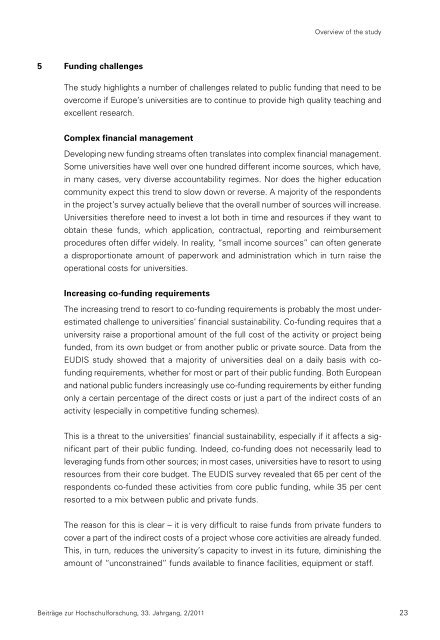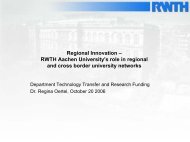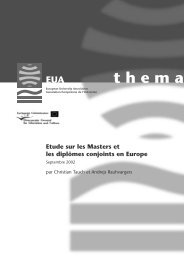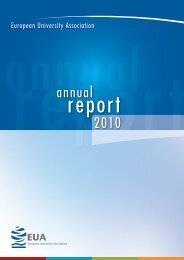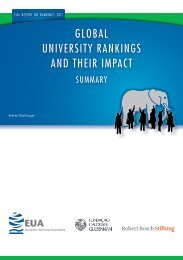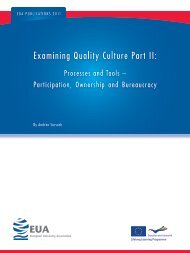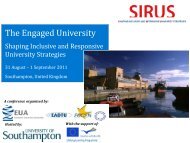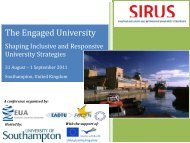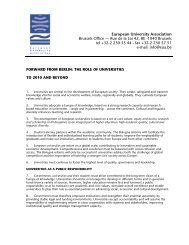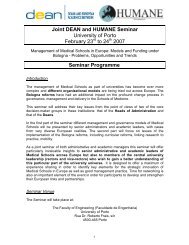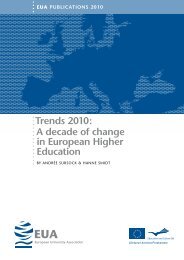Beiträge zur Hochschulforschung - European University Association
Beiträge zur Hochschulforschung - European University Association
Beiträge zur Hochschulforschung - European University Association
You also want an ePaper? Increase the reach of your titles
YUMPU automatically turns print PDFs into web optimized ePapers that Google loves.
5 Funding challenges<br />
Overview of the study<br />
The study highlights a number of challenges related to public funding that need to be<br />
overcome if Europe’s universities are to continue to provide high quality teaching and<br />
excellent research.<br />
Complex financial management<br />
Developing new funding streams often translates into complex financial management.<br />
Some universities have well over one hundred different income sources, which have,<br />
in many cases, very diverse accountability regimes. Nor does the higher education<br />
community expect this trend to slow down or reverse. A majority of the respondents<br />
in the project’s survey actually believe that the overall number of sources will increase.<br />
Universities therefore need to invest a lot both in time and resources if they want to<br />
obtain these funds, which application, contractual, reporting and reimbursement<br />
procedures often differ widely. In reality, “small income sources” can often generate<br />
a disproportionate amount of paperwork and administration which in turn raise the<br />
operational costs for universities.<br />
Increasing co-funding requirements<br />
The increasing trend to resort to co-funding requirements is probably the most under-<br />
estimated challenge to universities’ financial sustainability. Co-funding requires that a<br />
university raise a proportional amount of the full cost of the activity or project being<br />
funded, from its own budget or from another public or private source. Data from the<br />
EUDIS study showed that a majority of universities deal on a daily basis with co-<br />
funding requirements, whether for most or part of their public funding. Both <strong>European</strong><br />
and national public funders increasingly use co-funding requirements by either funding<br />
only a certain percentage of the direct costs or just a part of the indirect costs of an<br />
activity (especially in competitive funding schemes).<br />
This is a threat to the universities’ financial sustainability, especially if it affects a sig-<br />
nificant part of their public funding. Indeed, co-funding does not necessarily lead to<br />
leveraging funds from other sources; in most cases, universities have to resort to using<br />
resources from their core budget. The EUDIS survey revealed that 65 per cent of the<br />
respondents co-funded these activities from core public funding, while 35 per cent<br />
resorted to a mix between public and private funds.<br />
The reason for this is clear – it is very difficult to raise funds from private funders to<br />
cover a part of the indirect costs of a project whose core activities are already funded.<br />
This, in turn, reduces the university’s capacity to invest in its future, diminishing the<br />
amount of “unconstrained” funds available to finance facilities, equipment or staff.<br />
<strong>Beiträge</strong> <strong>zur</strong> <strong>Hochschulforschung</strong>, 33. Jahrgang, 2/2011 23


